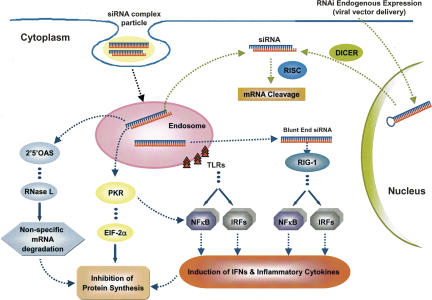FIGURE 3.
Activation of immune response by siRNAs. siRNA/shRNA can be delivered by two different ways: (1) Delivery of viral vector followed by endogenous expression of shRNA in the nucleus, which is transported to the cytoplasm and processed by Dicer into siRNAs. The siRNA causes sequence-specific mRNA degradation and does not induce an interferon (IFN) response. (2) Synthetic delivery systems forming an siRNA complex particle, for example, liposome. In this way, the siRNA is taken up by the cell via endocytosis, causing sequence-specific mRNA cleavage through RNAi and activation of the immune response. The immune response can be activated by different pathways: (a) recognition of siRNAs by Toll-like receptors (TLRs); (b) activation of retinoic acid-inducible gene I (RIG-I) by blunt-end siRNAs; (c) activation of dsRNA-dependent protein kinase R (PKR); (d) activation of 2′-5′-oligoadenylate synthetases (2′5′-OAS). Generally, activation of these pathways leads to the induction of several cellular factors, including nuclear factor κB (NF-κB), interferon regulatory factors (IRFs), eukaryotic translation initiation factor 2α (EIF-2α), and RNase L. Induction of interferons (IFNs), inflammatory cytokines, nonspecific mRNA degradation, and general inhibition of protein synthesis are some undesired effects of the immunostimulation caused by siRNAs.

